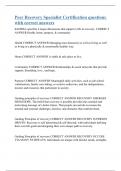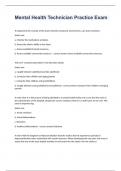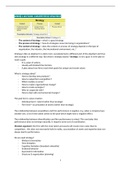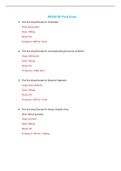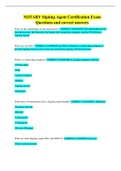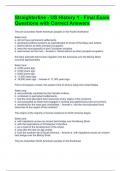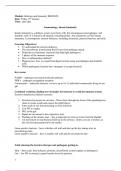Terms International Competitive Analysis & Strategy
, Economics Primer: Basic Principles
Term Definition
Law of Demand All other things being equal, the lower the price of a product, the more consumers will
purchase. Whether the increase in units sold (quantity) translates into higher revenues
depends on strength of relationship between price and quantity = price elasticity of demand.
Total Cost Function (TC) Relation between firms total cost (TC) and total amount of output (Q) it produces in a given
amount of time must slope upward. It is an efficiency relation showing the lowest
possible TC the firm would incur to produce a level of output, given the firm’s capabilities.
Variable Costs (VC) Such as direct labor and commissions to salespeople, increase as output increases.
Fixed Cost (FC) General and administrative expenses and property taxes, remain constant as output increases
(invariant).
Semifixed Cost Are costs between intervals (e.g., 0-500 and 501-1000) costs are fixed over certain ranges of
output but variable between other ranges.
Average Cost Function (ACF) Describes how the firm’s average or per-unit-of-output costs vary with the amount of output
it produces. AC(Q) = TC(Q) / Q.
- When AC decreases as output increases, economies of scale
- When AC increases as output increases, diseconomies of scale
- When AC remains unchanged with respect to output, constant returns to scale
- Smallest level of output at which economies of scale are exhausted = MES =
Minimum Efficient Scale
Marginal Efficient Scale (MES) Smallest level of output at which economies of scale are exhausted = MES = Minimum
Efficient Scale. Left side is economies of scale, right side is first constant returns to scale
which is caused by MES, then diseconomies of scale follows.
Marginal Cost Function (MC) Equals the cost to manufacture one additional unit of sale.
Sunk Costs Some costs may/must be incurred no matter what decision and thus cannot be avoided and
cannot be recovered (gasoline when driving to store to buy television).
Avoidable Costs These can be avoided if certain choices are made when weighting decisions, decision maker
should ignore sunk costs and only consider avoidable costs.
Demand Function Law of Demand if price falls, demand rises.
Price Elasticity of Demand (η ) Is the % change in quantity brought about by a 1% change in price.
η = Proportionate change in quantity
Proportionate change in price
η = (∆ Q / Q) * 100%
(∆ P / P) * 100%
If η < 1 inelastic price sensitive MR < 0 (negative), increase in output brought by
reduction in price lower total sales revenues.
If η > 1 elastic less price sensitive MR > 0 (positive), increase in output brought by
reduction in price will raise total sales revenues.
Revenue Destruction Effect With a downward-sloping demand curve, the firm must lower its price to sell more. While it
generates revenue on all units it sells at lower price, it reduces revenue on all units it would
have sold on a higher price. Whether MR is positive or negative depends on price elasticity
of demand.
Marginal Revenue Equals revenue obtained from sale of one additional unit. MR is twice as steep as demand
curve MR is below demand curve at all points, except for the point where one unit is
produced, this is because there P=MR only for first unit sold. You had to reduce your price
to sell additional units.
, If MC < MR firm can increase profit by selling more, ∆ Q > 0, to do so, it should lower
its price (law of demand).
If MC > MR firm can increase profits by selling less, ∆ Q > 0, to do so, it should higher
its price (law of demand).
If MC = MR optimal price and quantity levels.
Marginal Cost Refer to the rate of change of TC with respect to output the incremental cost of producing
exactly one more unit of output.
Nash Equilibrium Optimal decision making when all decision makers are presumed to be rational players and
each is attempting to anticipate actions/reactions of competitors. Each player is doing the
best it can, given the strategies of other players.
SPNE Subgame Perfect Nash Equilibrium: sequential decision making game tree.
, Economics Primer: Basic Principles
Term Definition
Law of Demand All other things being equal, the lower the price of a product, the more consumers will
purchase. Whether the increase in units sold (quantity) translates into higher revenues
depends on strength of relationship between price and quantity = price elasticity of demand.
Total Cost Function (TC) Relation between firms total cost (TC) and total amount of output (Q) it produces in a given
amount of time must slope upward. It is an efficiency relation showing the lowest
possible TC the firm would incur to produce a level of output, given the firm’s capabilities.
Variable Costs (VC) Such as direct labor and commissions to salespeople, increase as output increases.
Fixed Cost (FC) General and administrative expenses and property taxes, remain constant as output increases
(invariant).
Semifixed Cost Are costs between intervals (e.g., 0-500 and 501-1000) costs are fixed over certain ranges of
output but variable between other ranges.
Average Cost Function (ACF) Describes how the firm’s average or per-unit-of-output costs vary with the amount of output
it produces. AC(Q) = TC(Q) / Q.
- When AC decreases as output increases, economies of scale
- When AC increases as output increases, diseconomies of scale
- When AC remains unchanged with respect to output, constant returns to scale
- Smallest level of output at which economies of scale are exhausted = MES =
Minimum Efficient Scale
Marginal Efficient Scale (MES) Smallest level of output at which economies of scale are exhausted = MES = Minimum
Efficient Scale. Left side is economies of scale, right side is first constant returns to scale
which is caused by MES, then diseconomies of scale follows.
Marginal Cost Function (MC) Equals the cost to manufacture one additional unit of sale.
Sunk Costs Some costs may/must be incurred no matter what decision and thus cannot be avoided and
cannot be recovered (gasoline when driving to store to buy television).
Avoidable Costs These can be avoided if certain choices are made when weighting decisions, decision maker
should ignore sunk costs and only consider avoidable costs.
Demand Function Law of Demand if price falls, demand rises.
Price Elasticity of Demand (η ) Is the % change in quantity brought about by a 1% change in price.
η = Proportionate change in quantity
Proportionate change in price
η = (∆ Q / Q) * 100%
(∆ P / P) * 100%
If η < 1 inelastic price sensitive MR < 0 (negative), increase in output brought by
reduction in price lower total sales revenues.
If η > 1 elastic less price sensitive MR > 0 (positive), increase in output brought by
reduction in price will raise total sales revenues.
Revenue Destruction Effect With a downward-sloping demand curve, the firm must lower its price to sell more. While it
generates revenue on all units it sells at lower price, it reduces revenue on all units it would
have sold on a higher price. Whether MR is positive or negative depends on price elasticity
of demand.
Marginal Revenue Equals revenue obtained from sale of one additional unit. MR is twice as steep as demand
curve MR is below demand curve at all points, except for the point where one unit is
produced, this is because there P=MR only for first unit sold. You had to reduce your price
to sell additional units.
, If MC < MR firm can increase profit by selling more, ∆ Q > 0, to do so, it should lower
its price (law of demand).
If MC > MR firm can increase profits by selling less, ∆ Q > 0, to do so, it should higher
its price (law of demand).
If MC = MR optimal price and quantity levels.
Marginal Cost Refer to the rate of change of TC with respect to output the incremental cost of producing
exactly one more unit of output.
Nash Equilibrium Optimal decision making when all decision makers are presumed to be rational players and
each is attempting to anticipate actions/reactions of competitors. Each player is doing the
best it can, given the strategies of other players.
SPNE Subgame Perfect Nash Equilibrium: sequential decision making game tree.




